13th FE-FC Holden Nationals - Orange, NSW
|
| Popular |
|---|
Home  Accommodation
Accommodation  Nationals Classing Guidelines
Nationals Classing Guidelines
 Accommodation
Accommodation  Nationals Classing Guidelines
Nationals Classing Guidelines  |
| Nationals Classing Guidelines |

|

|
|
The 13th FE-FC Holden Nationals sees the official introduction of a new classification scheme for vehicles. From now on, vehicles will be separated into three classes:
• Stock: For Vehicles in or restored to Original Factory Condition • Street: For Vehicles that have been mildly modified or improved for regular use • Modified: For Vehicles that have been extensively modified from original specifications The purpose of this article is to describe the differences between these classes, why it matters, and to offer some guidelines to help entrants select the most appropriate class for their vehicles. Common Judging CriteriaAll vehicles are primarily judged on the Quality, Fit and Finish (QFF) of the car as presented at the Show 'n' Shine. QFF takes no consideration of originality, authenticity, or degree of difficulty of work done to the vehicle. Irrespective of whether the car is original, restored, modified or customised, each car is evaluated for quality of work (ie panel fit, paint, chrome work, interior trimming and so on), and for the general presentation (ie cleanliness, detailing, condition). This is very much in keeping with most judged car shows.The Exterior, Interior and Mechanicals are each judged on QFF for a maximum of 100 points each, giving a combined total of 300. StockVehicles entered in Stock class receive a score from a total of 400 points. 300 from the Common Judging Criteria, and 100 points for Authenticity. All cars in Stock class are automatically awarded 100 points, and points are then deducted for aspects of the car that are not 'authentic'. (The penalties are down to a minimum of zero, a negative authenticity score is not possible.) More detail on Authenticity will be the focus of a forthcoming article.StreetVehicles in Street Class are judged solely on the Common Judging Criteria.ModifiedVehicles entered in Modified class may receive a score of up to 330 points. 300 points based on the Common Judging Criteria, and 30 additional points as determined by the judges for 'engineering excellence'. These points are a reflection of both the degree of difficulty involved in the modifications performed, and the overall improvement achieved. It is not the case that more modifications automatically leads to a higher score. Engineering Excellence is simply a mechanism by which judges can separate two cars with equal Common Judging Criteria points, on the basis (for example) that a V6 conversion is a greater challenge than a red motor conversion, and should be recognised as such.Classes and TrophiesGiven the different methodologies used, it is clear that the old Top Ten format can no longer be used - it is not possible to compare scores out of 400, 300 and 330. For this reason, each class is judged completely independently. There will be a Grand Champion and a Top Five (or appropriate number) in each of these categories.Which Class Should I Enter My Vehicle In?You can enter your vehicle in any class you wish. The guidelines given below are to assist you, but they are not proscriptive. That being said, your club delegates can help you in selecting the right class if you are unsure, and the Nationals Delegates group reserve the right to reclassify vehicles that have been entered inappropriately. "Stock" is a known standard, but variation from that is a continuum, and every vehicle is going to be different. But with each class being judged on different criteria, choosing the right class should be common sense:⁃ if you haven't modified your car in any way, or the modifications are minor and you accept that you may lose some points for them, choose Stock ⁃ if you have made minor (typically "bolt-on") modifications, and/or your car is painted/trimmed in a non-original fashion, choose Street ⁃ if you've extensively modified your vehicle and want the engineering and technical achievement of what you've built taken into consideration, choose Modified. Use the following table to scrutineer your vehicle. If the exact modification you've done isn't listed here, choose something close and adjust it appropriately.
Any vehicle that scores 10 or more points is unlikely to fare well in Stock, and should be entered in Street or Modified. Any vehicle scoring 40 or more points should almost certainly be in Modified class. As a rule of thumb, any vehicle that would require or has an engineer's certificate (according to the NSW RTA or VicRoads) should probably be entered in Modified. (This is not a hard and fast rule, as rules for certification vary from one state to another.) Examples of Stock Class Vehicles:• Unrestored and unmodified• Faithfully restored to factory condition Examples of Street Class Vehicles:• Stock driveline, with unoriginal colours, finishes, mag/chrome wheels• Stock driveline, with performance equipment (ie headers, multiple carbs, electronic ignition etc) • Original appearance, with 138/149 red motor but otherwise stock mechanicals • Original appearance, with HR front end and stereo fitted Examples of Modified Vehicles:
• V6 or V8 driveline
• Completely replaced driveline, ie 186/Trimatic, HR front and read end • Significantly customised bodywork, ie flip-front, tubs Hopefully this article has helped you understand the aim of having three distinct classes, and given you a guide to selecting the right class for your vehicle. If you're unsure, ask your local Nationals delegate, or send an email to This e-mail address is being protected from spam bots, you need JavaScript enabled to view it
You can download a copy of this article in its original PDF format , as published in Sideplate Vol 28 No 4.
|
|||||||||||||||||||||||||||||||||||||||||||||||||
| Newsflash | ||
|---|---|---|
|
||
| Polls |
|---|
| Who's Online |
|---|
| We have 1 guest online |

